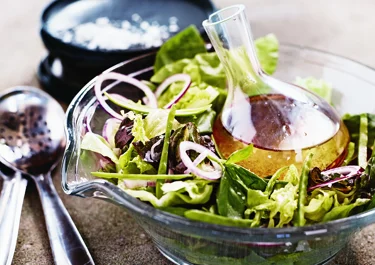Vinaigrette

Our recipe for vinaigrette is the quintessential base for any dressing, made with nothing more than oil, vinegar, salt, and pepper. Keep it as it is for a sharp, tangy salad dressing, or season it with garlic, Dijon mustard, herbs, or whatever suits your mood. Whether you drizzle it over a simple salad, use it in a marinade, or even dip crusty bread into it, this recipe is a must-have!
Ingredients
|
Oil
|
100 ml |
|---|---|
|
Red wine vinegar or white wine vinegar
|
50 ml |
|
Salt
|
½ tsp |
|
Pepper
|
½ tsp |
Suggestions for seasonings
|
Garlic clove, pressed
|
1 |
|---|---|
|
Dijon mustard
|
1 tbsp |
|
Herbs, chopped
|
2 tbsp |
Instructions
Recommended information
Serving suggestion
Select high-quality oil and vinegar
Because this dressing is so simple, every ingredient stands out, so the oil and vinegar you choose will shape the flavour. Extra virgin olive oil brings a bold, slightly peppery kick, while sunflower or rapeseed oil keeps things mild. For a hint of nuttiness, walnut oil is a fantastic option. As for the vinegar, red wine vinegar has a deeper, slightly fruity tang, making it great for heartier salads. In comparison, white wine vinegar is lighter and more delicate, giving a brighter, more subtle acidity. Both are great choices, so go with what suits your salad best.
Emulsify for a smooth texture
Oil and vinegar naturally separate, but a good whisking blends them into a smooth, slightly thickened dressing. The quickest way to emulsify them is by using a small whisk or shaking them in a sealed jar. Mix until the vinaigrette looks well combined with no visible separation. While it will hold for a while, it will gradually separate again, so give it another shake or whisk just before using it.
Let it rest for deeper flavour
If you are keeping the vinaigrette plain, there is no need to let it rest. But if you have added garlic, mustard, or herbs, giving it 10–15 minutes allows the flavours to blend. Store it in the fridge, and if it has been chilled, let it come to room temperature and shake it before using.
FAQ: Questions about vinaigrette
A homemade vinaigrette can improve any salad, grain bowl, or marinade. But how do you get the balance right? We have compiled answers to some of the most commonly asked questions below.
What is vinaigrette?
A vinaigrette is a simple, flavourful salad dressing made by mixing oil and vinegar. Since they naturally separate, they need to be whisked or shaken together to create a smooth, slightly thickened dressing. The dressing can be flavoured with ingredients like salt, pepper, mustard, garlic, or a bit of honey. Vinaigrettes are not just for salads – they also work well as marinades or drizzled over roasted vegetables.
What is the basic ratio for making vinaigrette?
The basic ratio of oil to vinegar for vinaigrette is usually 3:1, but our recipe uses a 2:1 ratio for a sharper, tangier flavour. The ratio is not set in stone, so feel free to adjust the amounts to suit your taste. Use more oil for a milder taste or more vinegar for extra sharpness. For instance, robust greens like kale can handle more acidity, while softer lettuces like lamb's lettuce work better with a milder dressing.
Can I prepare the vinaigrette in advance?
Yes, vinaigrette can be made ahead of time and stored in the fridge. If kept plain, it will last for up to 2 weeks. If you have added garlic, mustard, or herbs, it is best to use it within a week. Store it in a sealed jar or airtight container, and give it a good shake or whisk before using.
Nutritional values
Nutritional value, per
833 Kcal
| Fibre | 0.6 gram fibers |
| Protein | 1.7 gram |
| Carbohydrates | 5.5 gram |
| Fat | 90.9 gram |
Try the very best vinaigrette – simple and easy
Why bother with store-bought when you can whip up a proper vinaigrette in less time than it takes to grab your keys? Chances are, you already have the ingredients in your kitchen, and all it takes is a little whisking. Before you know it, you have a homemade dressing ready to go. Easy, right?
Rich and sharp with oil and vinegar
When whisked together, oil and vinegar blend into a smooth dressing. The oil creates a silky, rich feel, while the vinegar provides a sharp tang. Red wine vinegar has a deeper, slightly fruity acidity, giving the vinaigrette a more robust flavour. In contrast, white wine vinegar is lighter and more delicate, with a crisp, clean finish.
So, it all depends on what you are after. If you like a dressing with a bit more punch, red wine vinegar is the way to go. But if you prefer something more subtle and refreshing, white wine vinegar will keep things light and crisp.
Flavour with Dijon mustard, garlic, or herbs
Dijon mustard, garlic, and herbs are classic seasonings for a vinaigrette. The addition of mustard makes the dressing smoother and gives it a sharp edge. Garlic contributes a bold punch that only gets better as it rests. As for the herbs, choose parsley for its lightness and peppery undertone or thyme for its earthy and lemony flavour. You can combine them all or keep it simple with just one or two. Either way, you cannot go wrong.
Dress your favourite salads
Vinaigrette and a salad always go hand in hand. Drizzle it over a crisp green salad, a hearty mix of lentils and roasted vegetables, a fresh tomato and mozzarella plate, or any other salad you have in mind because our vinaigrette recipe works with almost anything. But salads are just the start!
Marinating meat in vinaigrette is a real game-changer, as its acidity helps tenderise the meat, making it extra juicy. It does wonders for tender cote de boeuf and juicy ribeye steaks, locking in flavour before they hit the grill. Lighter meats like chicken or even fish soak it up just as well, maintaining their natural taste.
Vinaigrette also excels as a finishing touch! A quick spoon over succulent tagliata deepens the flavour of the seared meat, while a splash on homemade crostini offers a tangy, zesty touch. It is just as good on grilled vegetables, roasted potatoes, or even stirred into warm grains like couscous or quinoa.
Adjust the recipe to your liking
Our vinaigrette recipe could not be simpler, so you can easily adjust it to your liking. Swap the red or white wine vinegar for balsamic if you want something richer and slightly sweet, apple cider vinegar for a mild fruity tang, or sherry vinegar for a nutty and woody aroma.
Once the vinegar is sorted, it is time to think about seasonings. A spoonful of honey softens the acidity with a touch of sweetness, while a squeeze of citrus, like lemon or orange, keeps things bright and fresh. If you enjoy heat, a pinch of chilli flakes or a dash of hot sauce does the trick.









